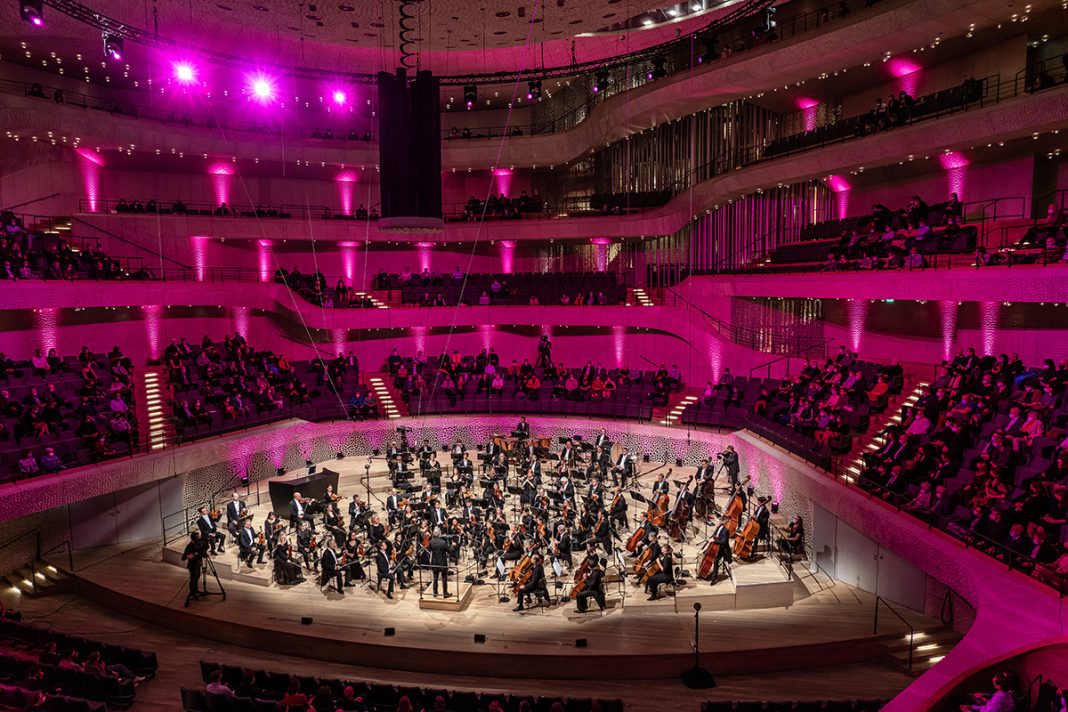Brought in by necessity during the COVID-19 pandemic, the idea of operating a show remotely became a recurring theme in the lockdown – rolled-out to great effect on projects such as Wacken World Wide [TPi #253] and Around The World In 80 Milliseconds [TPi #258]. Involved in both projects was none other than Peter Brandt of Remote Recording Network. Carving out somewhat of a niche, Brandt and his team, while working closely with Riedel Communications, have created a proven workflow, which enables a show to be operated remotely by engineers, using a mirrored console on site. This time round, for Beethoven X , Brandt has placed his faith in the Yamaha RIVAGE PM5 to create the mix for this intriguing project.
Beethoven X involved two distinct performances – one with the orchestra performing in Telekom Forum in Bonn and the other in the Elbphilharmonie, Hamburg, with each show being operated remotely from Studio Boecker, Cologne and Teldex Studios, Berlin, respectively. “I’ve been working with Telekom since 2007,” began Brandt, explaining how he was brought into this project.
The score which the orchestra were playing was a piece of music that had been created by AI, finishing Beethoven’s incomplete 10th Symphony. “In the mix, you can really hear hints on Beethoven’s other works, such as the 5th Symphony,” enthused Brandt, who is now more than familiar with the pieces of work.
Having worked on numerous remote shows, Brandt marked this project as somewhat of a turning point. Many of the prior performances were all about proving the concept that remote productions can work, but with the concept now proved, for these two shows, he was able to focus on the mix and choose spaces that were ideal for the orchestra and a studio ideal for mixing this type of performance.
“With this type of streamed show, you used to be limited in what you could do as you would most likely be based in a truck outside the building,” stated Brandt. “However, with remote mixing, we were able to choose studios that were designed to work on classical mixes.”
Talking more specifically about his workflow, the engineer outlined why the Yamaha PM5 was chosen. “We tested various consoles prior to the show and, simply put, the Yamaha desks just worked,” chuckled Brandt.
With two desks in the audio chain – one on site with the orchestra and the other in the studio – Brandt recalled how the mirror imaging was relatively easy to set up. “I’m a big fan of the PM5 as it reminds me of the old-school analogue days,” he continued. “The workflow is very easy for those who grew up on those styles of desks. It only took me 20 minutes or so to get the basic functionality up and running to be ready to do the mix.”
Yamaha’s Arthur Koll expanded on Brandt’s comment regarding the analogue feel of the digital desk. “The basic thinking of the RIVAGE series was that it would be like a big analogue console rather than having to lay out numerous extra screens,” Koll explained. “It’s getting back to the mentality that the job will work no matter what you throw at it.”
Koll added that the R&D team’s priority was the desk’s new IOs. “I’ve supported several other classical shows and all the engineers were pleased with the sound of the new RPIOs and the Neve Simulations preamps.” Brandt agreed whole-heartedly. “It was not only the desk’s ability to work in the remote set up – the sound of the console also made it the ideal choice,” he stated.
The idea of the desk being used in a remote environment clearly was not the goal when it was created and Koll spoke of Yamaha’s opinion on this new way of using its consoles.
“The engineers behind the RIVAGE range made a very clever decision early on that all communication for the surfaces, all the way down to the DSP, would be done on IP. They are perfectly suited to remote productions as all the communication is IP based,” Brandt added. “This wasn’t an original intention of the R&D team, but it’s now worked in our favour.”
Riedel Communications was key to the success of the project. “We joked on site that at one time a truck driver used to bring all our equipment from A to B, but now we have a Riedel engineer sending our data from A to B,” chuckled Brandt, who was complimentary of the service provided by the company. “They are now a part of everything we do when it comes to remote productions – especially with the use of The ROC [Riedel’s Remote Operations Centre].”
He enthused that thanks to the company’s help, Remote Show Productions is almost at a stage where it can provide a plug-and-play solution for this style of performance. “There still needs to be an IT person on hand to check everything is running and observe internet speeds, but we have learned a lot in the past year,” he concluded.
Projects such as this and the 5G Festival Trial [see p10] demonstrate how far we have come in such a short space of time. Remote options are becoming ever more sophisticated, giving event organisers and promoters even more options when it comes to working out the logistics of a performance.
This article originally appeared in issue #267 of TPi, which you can read here.






